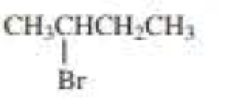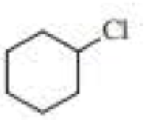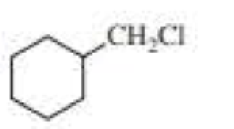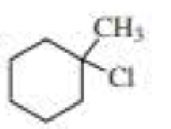
EBK ORGANIC CHEMISTRY
8th Edition
ISBN: 8220102744127
Author: Bruice
Publisher: PEARSON
expand_more
expand_more
format_list_bulleted
Concept explainers
Textbook Question
Chapter 9, Problem 83P
Draw the major product obtained when each of the following






Expert Solution & Answer
Trending nowThis is a popular solution!

Students have asked these similar questions
1. For the four structures provided, Please answer the following questions in the table
below.
a. Please draw π molecular orbital diagram (use the polygon-and-circle method if
appropriate) and fill electrons in each molecular orbital
b. Please indicate the number of π electrons
c. Please indicate if each molecule provided is anti-aromatic, aromatic, or non-
aromatic
TT MO diagram
Number of π e-
Aromaticity Evaluation (X choose one)
Non-aromatic
Aromatic
Anti-aromatic
||
|||
+
IV
1.3 grams of pottasium iodide is placed in 100 mL of o.11 mol/L lead nitrate solution. At room temperature, lead iodide has a Ksp of 4.4x10^-9. How many moles of precipitate will form?
Q3: Circle the molecules that are optically active:
ДДДД
Chapter 9 Solutions
EBK ORGANIC CHEMISTRY
Ch. 9.1 - Prob. 3PCh. 9.1 - Does increasing the energy barrier for an SN2...Ch. 9.1 - Rank the following alkyl bromides from most...Ch. 9.1 - Prob. 8PCh. 9.2 - Prob. 9PCh. 9.2 - Prob. 10PCh. 9.2 - Prob. 11PCh. 9.2 - Prob. 12PCh. 9.2 - Which substitution reaction lakes place more...Ch. 9.2 - Prob. 15P
Ch. 9.2 - Prob. 17PCh. 9.3 - Prob. 18PCh. 9.4 - Prob. 19PCh. 9.5 - Draw the configuration(s) of the substitution...Ch. 9.5 - Which of the following reactions take place more...Ch. 9.7 - Prob. 22PCh. 9.7 - Prob. 23PCh. 9.7 - Prob. 24PCh. 9.7 - Prob. 25PCh. 9.8 - Four alkenes are formed from the E1 reaction of...Ch. 9.8 - If 2-fluoropentane could undergo an E1 reaction,...Ch. 9.8 - Prob. 28PCh. 9.8 - Propose a mechanism for the following reaction:Ch. 9.9 - Prob. 30PCh. 9.9 - What percentage of the reaction described in...Ch. 9.10 - Prob. 33PCh. 9.10 - Prob. 35PCh. 9.11 - Why do cis-1-bromo-2-ethylcyclohexane and...Ch. 9.11 - Which isomer reacts more rapidly in an E2...Ch. 9.11 - Prob. 38PCh. 9.12 - Prob. 39PCh. 9.12 - Prob. 40PCh. 9.12 - Prob. 41PCh. 9.12 - Explain why only a substitution product and no...Ch. 9.12 - a. Explain why 1-bromo-2,2-dimethylpropane has...Ch. 9.13 - Prob. 44PCh. 9.13 - Prob. 45PCh. 9.13 - What products will be obtained from the El...Ch. 9.13 - Prob. 47PCh. 9.13 - Prob. 48PCh. 9.13 - Prob. 49PCh. 9.13 - Why is a cumulated diene not formed in the...Ch. 9.13 - What product is obtained when the following...Ch. 9.13 - What products are formed from the following...Ch. 9.14 - Prob. 54PCh. 9.14 - Prob. 55PCh. 9.14 - Prob. 56PCh. 9.14 - Prob. 58PCh. 9.14 - Under which of the following reaction conditions...Ch. 9.15 - A small amount of another organic product is...Ch. 9.15 - What is the best way to prepare the following...Ch. 9.15 - Prob. 62PCh. 9.15 - What products (including stereoisomers, if...Ch. 9.16 - After a proton is removed from the OH group, which...Ch. 9.16 - Prob. 65PCh. 9.17 - Prob. 66PCh. 9 - Prob. 1PCh. 9 - Methoxychlor is an insecticide that was intended...Ch. 9 - Prob. 67PCh. 9 - Prob. 68PCh. 9 - Prob. 69PCh. 9 - Prob. 70PCh. 9 - Prob. 71PCh. 9 - Prob. 72PCh. 9 - Starting with cyclohexene, how can the following...Ch. 9 - Prob. 74PCh. 9 - The pKa of acetic acid in water is 4.76. What...Ch. 9 - Prob. 76PCh. 9 - Prob. 77PCh. 9 - Prob. 78PCh. 9 - Prob. 79PCh. 9 - Prob. 80PCh. 9 - Prob. 81PCh. 9 - Prob. 82PCh. 9 - Draw the major product obtained when each of the...Ch. 9 - Prob. 84PCh. 9 - a. Indicate how each of the following factors...Ch. 9 - Prob. 86PCh. 9 - A chemist wanted to synthesize the...Ch. 9 - Prob. 88PCh. 9 - Prob. 89PCh. 9 - Prob. 90PCh. 9 - Prob. 91PCh. 9 - Starting with an alkyl halide, how could the...Ch. 9 - Indicate which species in each pair gives a higher...Ch. 9 - Prob. 94PCh. 9 - Rank the following from most reactive to least...Ch. 9 - For each of the following alkyl halides, indicate...Ch. 9 - Prob. 97PCh. 9 - When 2-bromo-2,3-dimethylbutane reacts with a...Ch. 9 - Prob. 100PCh. 9 - When the following compound undergoes solvolysis...Ch. 9 - cis-1-Bromo-4-tert-butylcyclohexane and...Ch. 9 - Draw the substitution and elimination products.Ch. 9 - tert-Butyl chloride undergoes solvolysis in both...Ch. 9 - Prob. 105PCh. 9 - Prob. 106PCh. 9 - In which solventethanol or diethyl etherwould the...Ch. 9 - Prob. 108PCh. 9 - Two bromoethers are obtained from the reaction of...Ch. 9 - Prob. 110PCh. 9 - Prob. 111PCh. 9 - Prob. 112PCh. 9 - Which of the following hexachlorocyclohexanes is...Ch. 9 - Explain why the rate of the reaction of...Ch. 9 - Prob. 115PCh. 9 - Two elimination products are obtained from the...Ch. 9 - Draw the structures or the product of the obtained...Ch. 9 - How could you prepare the following compounds from...Ch. 9 - cis-4-Bromocyclohexanol and...Ch. 9 - Prob. 120PCh. 9 - Propose a mechanism for the following reaction:Ch. 9 - Prob. 122PCh. 9 - Prob. 123PCh. 9 - Prob. 124PCh. 9 - Prob. 125PCh. 9 - Predict the product for the following reaction and...Ch. 9 - Prob. 127PCh. 9 - Prob. 128PCh. 9 - When equivalent amounts of methyl bromide nod...Ch. 9 - Prob. 130PCh. 9 - The reaction of chloromethane with hydroxide ion...
Knowledge Booster
Learn more about
Need a deep-dive on the concept behind this application? Look no further. Learn more about this topic, chemistry and related others by exploring similar questions and additional content below.Similar questions
- 6. How many peaks would be observed for each of the circled protons in the compounds below? 8 pts CH3 CH3 ΤΙ A. H3C-C-C-CH3 I (₁₁ +1)= 7 H CI B. H3C-C-CI H (3+1)=4 H LIH)=2 C. (CH3CH2-C-OH H D. CH3arrow_forwardNonearrow_forwardQ1: Draw the most stable and the least stable Newman projections about the C2-C3 bond for each of the following isomers (A-C). Are the barriers to rotation identical for enantiomers A and B? How about the diastereomers (A versus C or B versus C)? H Br H Br (S) CH3 (R) CH3 H3C (S) H3C H Br Br H A C enantiomers H Br H Br (R) CH3 H3C (R) (S) CH3 H3C H Br Br H B D identicalarrow_forward
- 2. Histamine (below structure) is a signal molecule involved in immune response and is a neurotransmitter. Histamine features imidazole ring which is an aromatic heterocycle. Please answer the following questions regarding Histamine. b a HN =N C NH2 a. Determine hybridization of each N atom (s, p, sp, sp², sp³, etc.) in histamine N-a hybridization: N-b hybridization: N-c hybridization: b. Determine what atomic orbitals (s, p, sp, sp², sp³, etc.) of the lone pair of each N atom resided in N-a hybridization: N-b hybridization: N-c hybridization:arrow_forwardNonearrow_forward29. Use frontier orbital analysis (HOMO-LUMO interactions) to decide whether the following dimerization is 1) thermally allowed or forbidden and 2) photochemically allowed or forbidden. +arrow_forward
- 30.0 mL of 0.10 mol/L iron sulfate and 20.0 mL of 0.05 mol/L of silver nitrate solutions are mixed together. Justify if any precipitate would formarrow_forwardDoes the carbonyl group first react with the ethylene glycol, in an intermolecular reaction, or with the end alcohol, in an intramolecular reaction, to form a hemiacetal? Why does it react with the alcohol it does first rather than the other one? Please do not use an AI answer.arrow_forwardThe number of noncyclic isomers that have the composition C4H8Owith the O as part of an OH group, counting a pair of stereoisomers as1, is A. 8; B. 6; C. 9; D. 5; E. None of the other answers is correct.arrow_forward
- Nonearrow_forwardThe number of carbon skeletons that have 8 carbons, one of which istertiary is A. 7; B. More than 7; C. 6; D. 5; E. 4arrow_forwardThe azide ion is N3^-. In addition to the ionic charge, it’s three mostimportant contributing structures also have formal charges. The totalnumber of π bonds in these three contributing structures isA. 6; B. 12; C. 3; D. 9; E. None of the other answers is correct.arrow_forward
arrow_back_ios
SEE MORE QUESTIONS
arrow_forward_ios
Recommended textbooks for you
 Organic ChemistryChemistryISBN:9781305580350Author:William H. Brown, Brent L. Iverson, Eric Anslyn, Christopher S. FootePublisher:Cengage Learning
Organic ChemistryChemistryISBN:9781305580350Author:William H. Brown, Brent L. Iverson, Eric Anslyn, Christopher S. FootePublisher:Cengage Learning

Organic Chemistry
Chemistry
ISBN:9781305580350
Author:William H. Brown, Brent L. Iverson, Eric Anslyn, Christopher S. Foote
Publisher:Cengage Learning
Alcohols, Ethers, and Epoxides: Crash Course Organic Chemistry #24; Author: Crash Course;https://www.youtube.com/watch?v=j04zMFwDeDU;License: Standard YouTube License, CC-BY